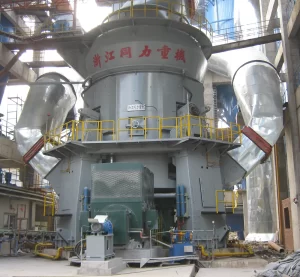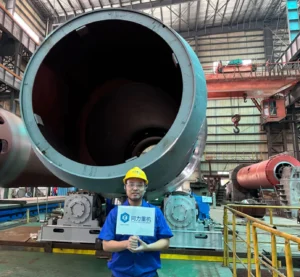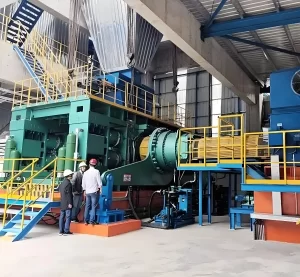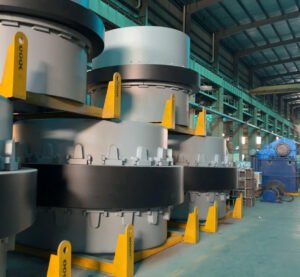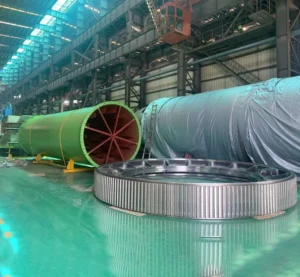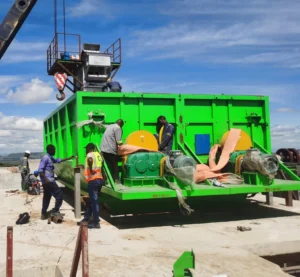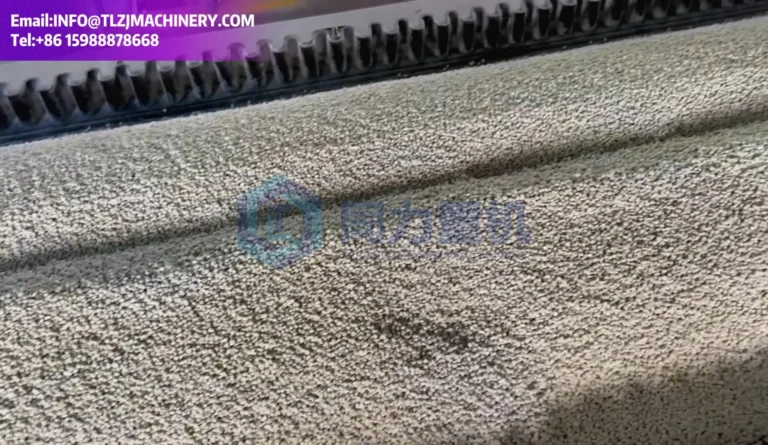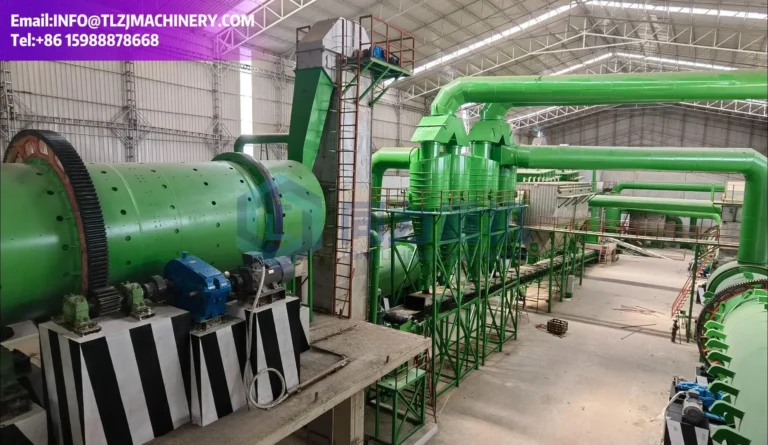TONGLI organic fertilizer production line is a production system that processes organic waste (such as livestock and poultry manure, crop straw, food waste, etc.) into organic fertilizer, capacity from 50,000-300,000 tons/year.
Tongli organic fertilizer production line focuses on environmental protection and efficient production. By processing up to tens of thousands of tons of organic waste each year, the organic fertilizer production line converts resources such as livestock and poultry manure and crop straw into high-quality organic fertilizer. The fermentation process adopts advanced fermentation compost turning machine technology, which greatly shortens the fermentation time to 7-15 days and increases the organic matter content. In order to control the particle size, efficient crushing and granulation equipment such as disc granulator or drum granulator is used to produce particles with a diameter of 3-5 mm to meet the needs of different crops. The drum dryer equipped with the production line can process 20-25 tons of materials per hour, ensuring that the moisture content of the particles is less than 15%, which is suitable for long-term storage.
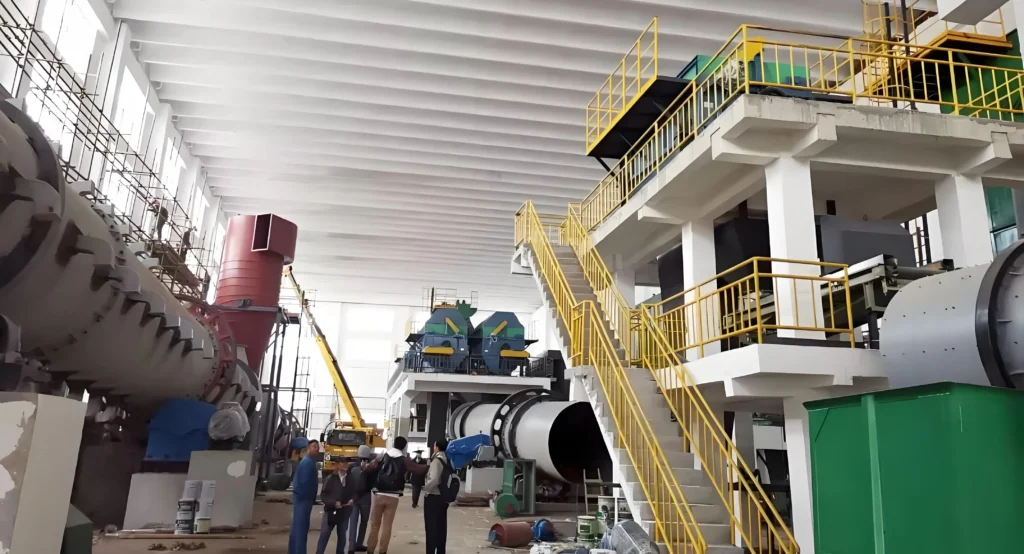
ORGANIC FERTILIZER PRODUCTION LINE EQUIPMENT LIST

The organic fertilizer granulator adopts wet granulation technology, which is suitable for organic raw materials with high water content. The raw materials are turned, fermented and dried before entering the granulator for granulation.

The organic fertilizer dryer is specially designed for high-moisture organic fertilizer particles. It uses coal powder injection hot air furnace for rapid drying while controlling the temperature below 300 degrees to prevent carbonization of organic matter.

The organic fertilizer cooler is used to quickly cool the high-temperature particles after drying to prevent the particles from softening or sticking. The high-power cooling fan is used to prevent moisture regain.

The organic fertilizer coating machine evenly coats the particles to enhance their anti-caking and moisture resistance. After coating, organic fertilizer particles with high moisture content can prevent agglomeration in a humid environment and improve storage stability.

Ensure the uniformity and stability of particles. After drying and cooling, high-moisture organic fertilizer can be screened to effectively reduce agglomeration and optimize the subsequent production process.
ORGANIC FERTILIZER PRODUCTION LINE ADVANTAGES
Temperature and humidity sensors and automatic compost turners are used to achieve precise fermentation environment control and effectively improve microbial activity.
Although organic fertilizer takes a long time to take effect, it has a long shelf life and can be used in combination with inorganic fertilizers to achieve a complementary effect.
The cooling system uses countercurrent technology, and the cooling time is shortened to 5 minutes to ensure the hardness of the particles.
The types of nutrients in organic fertilizers are more diverse.
Using a double-shaft crusher, the crushing efficiency is increased by 30%, ensuring that the material is fine and uniform, which is helpful for subsequent granulation.
Organic and inorganic fertilizers make full use of local resources to enhance the economic value of raw materials.
As a slow-release fertilizer, organic fertilizers have a long effective period, are released slowly, and are used in relatively large quantities.
This type of fertilizer is rich in organic matter and provides rich nutrient support for crop growth.
ORGANIC FERTILIZER PRODUCTION PROCESS

Raw Materials
Organic fertilizer is a kind of biological fertilizer made by mixing and fermenting the manure of poultry or livestock such as chickens and pigs with appropriate amounts of nitrogen fertilizer, phosphorus fertilizer, potassium fertilizer, magnesium sulfate and other substances, and combining with rice bran, yeast, soybean meal, sugar and other biological strains that have been fermented for a period of time under the action of sulfuric acid.
Fermentation
Compared with the traditional NPK compound fertilizer production line, the production process of organic-inorganic compound fertilizer adds a key step: fermentation and turning of organic matter. Due to the wide source of organic fertilizer raw materials, different raw materials lead to large differences in composition. The surface of the raw materials usually carries a large number of bacteria. If the pile is not turned, the bacteria in the fertilizer will multiply and affect plant growth. Organic fertilizer must be turned before use. This process helps to evenly mix the fertilizer ingredients and fully contact the bacteria with oxygen, thereby promoting its complete decomposition. The compost turner adopts a crawler walking mechanism that spans the top of the strip pile. The auger and stirring device under the frame begin to stir and turn the material. When the machine passes through the pile and completes the turning and moving, a new pile is formed, ensuring the uniformity and full fermentation of the fertilizer.
Pretreatment
The raw materials are crushed by bulk crusher, double cage crusher or chain mill ton bag crusher, and then mixed and humidified by disc mixer to create a physical state and environment suitable for the growth and reproduction of microorganisms. During the fermentation process, high temperature can kill harmful components such as pathogens, parasite eggs, weed seeds, etc. in the raw materials, thereby converting livestock and poultry manure into odorless organic fertilizer. The size and hardness of the fermented organic matter vary, so we are equipped with a crushing process, using bulk crusher or vertical crusher to further crush the fermented material to achieve the particle size required for the subsequent process, and then enter the belt scale or automatic batching system for raw material batching.
Automatic Batching System
After the organic matter is turned and fermented, it is crushed by a vertical crusher or a bulk crusher and then enters the automatic batching system. Compared with the NPK compound fertilizer production line, the uniqueness of the organic-inorganic compound fertilizer production line is that the organic matter is mixed into the inorganic compound fertilizer production line as a raw material. At this time, the automatic batching scale batches the crushed and turned organic matter according to a specific formula and ratio, and then enters the granulator for granulation. In the production process of organic-inorganic compound fertilizer, the accuracy and reliability of the automatic batching system are particularly important.
Granulation
In 1990, Tongli manufactured the first domestic compound fertilizer rotary steam granulator, achieving a breakthrough from 0 to 1. Traditional granulators need to add water, which increases the workload of subsequent fertilizer dryers and coolers, while the use of steam perfectly solves the energy consumption problem. High-temperature steam improves the balling rate of raw material powder in the granulator, effectively reduces energy consumption and improves fertilizer quality. Inside the granulator, Tongli uses a gravity dust removal system to achieve self-cleaning through the dead weight of the polymer film. At the same time, the front and rear ends of the granulator are equipped with double-layer sealing devices and unloading hoods to reduce dust emissions.
Drying
In the process of drying organic fertilizers, we provide two solutions: one is equipped with a dryer and a cooler, and the other is equipped with two dryers and a cooler. The main difference between the two solutions is the different control of the moisture content of the finished product. The configuration of two dryers and a cooler can better control the moisture content in the compound fertilizer, thereby producing products with higher particle size and quality. Compared with inorganic fertilizers, organic fertilizers contain more moisture, so the temperature requirements are also higher. Organic fertilizer will decompose at 200 to 300 degrees, so more precise temperature control is required. This not only increases the complexity of the process, but also places higher requirements on the stability and precision of the equipment. Although the configuration cost of two dryers and one cooler is relatively high, it is a worthwhile investment for companies pursuing efficient and high-quality production. This configuration can significantly reduce the moisture content of the fertilizer in a shorter time and improve the stability and storage life of the finished product. On the other hand, for companies with limited budgets or low requirements for product moisture control, choosing a configuration of one dryer and one cooler is also an economical solution. Our organic fertilizer drying line is usually equipped with two dryers, and the temperature of the first dryer is about 100 to 150 degrees lower than that of the second, because organic fertilizer has very high requirements for temperature control and heat. For this reason, we independently developed a coal-fired powder burner with unique advantages. Compared with traditional coal-fired hot air furnaces or natural gas burners, our coal-fired powder burner is more accurate and efficient in temperature control and heat supply, and is designed specifically for organic matter.
Cooling
After two dryings, the organic fertilizer will enter the drum-type compound fertilizer cooler. Due to its high moisture content, the humidity control requirements in the cooler are more stringent. In order to better cool the material and remove moisture, the air volume needs to be increased. Our cooler adopts a convection design, with air supplied by a high-power centrifugal fan at the tail, and the material contacts the supply air flow in reverse. Compared with ordinary coolers, organic fertilizer coolers have higher requirements for material wall adhesion. Although organic fertilizer has been dried twice, it has strong viscosity due to its raw material characteristics, so the cooler design must be more sophisticated. We increased the air volume of the cooler and redesigned the knocking device on the cooler barrel or shell to prevent the material from adhering to the inner wall. Through optimized design, the cooler not only improves the cooling efficiency, but also effectively solves the problem of material wall adhesion, ensuring the quality stability during the production of organic fertilizer.
Coating
Coating is a key link in the production of compound fertilizer. Its function is to introduce the finished products that have passed through the rotary screening machine and the cooler into the coating machine for surface treatment. The coating process of organic fertilizer is slightly different from that of inorganic fertilizer, mainly reflected in the fact that the color of inorganic fertilizer can be freely adjusted. Inorganic fertilizer is usually pure white, and finished products of various colors can be made through coating. However, due to the addition of organic matter (such as cow dung and sheep dung), the color of the finished product of organic fertilizer is brown and cannot be adjusted to bright colors. This is the main difference between organic fertilizer and inorganic fertilizer in the coating stage. The coating machine system is relatively complex. In addition to the coating machine itself, it also includes a coating oil tank and an automatic batching scale that controls the amount of compound fertilizer entering the coating machine. The amount of coating oil needs to match the finished product batching ratio, so a DCS control system is required to adjust the automatic batching speed and the amount of coating oil. During the coating process, an anti-caking agent screw conveyor is also provided to prevent the organic compound fertilizer particles from agglomerating or scattering. The anti-caking agent is quantitatively supplied to the coating machine through DCS control to ensure that it is evenly distributed with the coating oil in the finished product to prevent the particles from agglomerating or scattering. The strength of organic compound fertilizer particles after coating can usually reach about 15 Newtons.
Packaging
Regarding the finished compound fertilizer packaging machine, we provide two solutions: one is a semi-automatic packaging system and the other is a fully automatic packaging system. The traditional double-cylinder packaging scale has been eliminated, and the servo motor automatic quantitative packaging scale is now mainly used. This servo motor packaging scale is faster and more accurate, with a packaging speed of 800 to 1,000 bags per hour. The scale body of the packaging scale is made of S304 stainless steel, with a thickness ranging from four to eight millimeters. The main electronic components are from Schneider, and the pneumatic components are imported from Japan. After the material comes out of the fertilizer coating machine, it first enters the buffer silo of the finished product packaging scale, and then is automatically quantitatively packaged. The system is also equipped with automatic folding and automatic sewing systems to achieve semi-automatic packaging. If the automation requirements are higher, the fully automatic packaging system can better meet the needs. The difference lies in whether an automatic bagging machine is used. Automatic bagging machines improve efficiency and save labor, but the investment cost is higher.
VIDEO
WHY CHOOSE US
The cement production line is efficient, reliable, and provides consistent quality. Customer service and support are excellent. We're highly satisfied and would recommend it.

CFO
The cement production line is efficient, reliable, and provides consistent quality. Customer service and support are excellent. We're highly satisfied and would recommend it.

CEO
The cement production line is efficient, reliable, and provides consistent quality. Customer service and support are excellent. We're highly satisfied and would recommend it.

CEO
The cement production line is efficient, reliable, and provides consistent quality. Customer service and support are excellent. We're highly satisfied and would recommend it.

CEO
FAQ
Organic-inorganic compound fertilizer is a compound product that combines organic matter with inorganic fertilizers, designed to provide diversified nutritional support for crops.
Organic ingredients usually include animal manure, straw and green manure, which are rich in organic matter and trace elements, can improve the physical and chemical properties of the soil, promote microbial activity and enhance soil health.
Inorganic ingredients include chemical fertilizers such as nitrogen fertilizer, phosphorus fertilizer and potassium fertilizer, which release nutrients quickly and provide crops with immediately available nutrition. This type of compound fertilizer has the advantages of improving soil fertility, enhancing crop disease resistance, and reducing the environmental impact of fertilizer application.
Through reasonable proportions and scientific production processes, organic-inorganic compound fertilizers can support long-term soil health while meeting the short-term nutritional needs of crops, and are an important tool for promoting sustainable agricultural development.
The raw materials of organic-inorganic compound fertilizer production line are diverse, covering animal and plant residues and chemical fertilizer components.
Commonly used organic raw materials include livestock and poultry manure, straw, green manure, peat and kitchen waste, etc. These materials are rich in organic matter and trace nutrients, and have the effect of improving soil structure and fertility.
Inorganic fertilizer ingredients usually include urea, diammonium phosphate and potassium sulfate, etc., which can quickly provide the main nutrients such as nitrogen, phosphorus and potassium required for plant growth.
In order to improve the effect and stability of compound fertilizer, some trace elements such as zinc, iron, manganese, and beneficial microbial agents may also be added. These additives can further improve the nutrient utilization rate of fertilizers and soil microbial activity.
Fermentation is the most critical link in the production of organic fertilizers, which aims to convert raw materials into stable organic matter through microbial activity. The fermentation process usually includes three stages: heating, main fermentation and post-ripening.
1) The compost heats up rapidly under the action of microorganisms, reaching 50-60 degrees Celsius, which can kill most pathogens and insect eggs.
2) Next is the main fermentation stage, where the temperature is maintained at 40-50 degrees Celsius, and microorganisms continue to decompose organic matter, releasing organic acids and other nutrients.
3) Finally, the post-ripening stage, the temperature gradually drops, and the organic matter in the compost is converted into humus to form a stable organic fertilizer. Throughout the process, the compost needs to be turned regularly to ensure the supply of oxygen, and the humidity and temperature of the compost are controlled to optimize the activity of microorganisms and the quality of the compost.
TONGLI organic-inorganic compound fertilizer production lines usually have a high level of automation, so the demand for labor is relatively low.
Generally speaking, a small production line may require 3-5 operators to monitor the equipment and load and unload raw materials, while a large production line may require about 10 people for management and maintenance.
TONGLI organic fertilizer production line is equipped with an advanced control system that can monitor and adjust production parameters in real time, thereby reducing the need for manual intervention
Organic fertilizer is suitable for food crops, cash crops and horticultural crops. Since organic fertilizer can improve soil structure, increase soil biological activity and fertility, it is particularly suitable for crops that have requirements on soil, such as vegetables, fruits and flowers.
These crops usually have high demands for soil nutrients and microbial environment, and organic fertilizer can provide long-lasting and stable nutrient release to meet the needs of different stages of their growth.
For food crops, such as wheat, corn and rice, organic fertilizer can be used in combination with chemical fertilizers to improve soil nutrient levels and crop yields
1) Improving the nutrient content of organic fertilizer needs to start with the selection of raw materials and the optimization of processes. First, select raw materials with high nutrient content, such as poultry and livestock manure and plant residues rich in nitrogen, phosphorus and potassium.
2) In addition, the nutrient level can be increased by adding some natural minerals or biological additives. During the fermentation process, the activity of microorganisms and the stabilization of nutrients are promoted by controlling temperature, humidity and C/N ratio.
3) Modern technologies such as adding specific microbial agents can also accelerate the decomposition of organic matter and improve the effectiveness of nutrients. Finally, through scientific proportioning and processing technology, ensure that the nutrient content of each batch of fertilizer meets the expected standards.
ORGANIC FERTILIZER PRODUCTION LINE TECHNICAL PARAMETERS
| Product Name | Output | Detailed Information | Speed | Power |
| Crawler Turner | 440-1725m³/h | Stacking height: 600mm-1500mm | 5-10m/min | 36-170 HP |
| Forklift Feed Hopper | Silo size: 1-4 meters | 2250mm1050mm1590mm | N/A | On-site manufacturing |
| Vertical Crusher | 5.5-13.8t/h | Q235B with 2mm SS304 inner lining | 3000r/min | 7.5-37KW |
| Organic Fertilizer Granulator | 4.5-9t/h | Rotary drum/disc/extrusion/stirring teeth | 2~3r/min | 7.5-11KW |
| Polishing Machine | 5.5-11.5t/h | Double bearings | 2000r/min | 3-7.5KW |
| Rotary Drum Dryer | 22-28.75t/h | 2.5x25m | 1.5~2r/min | 25-37KW |
| Cooler | 16.5-23t/h | 2.2x20m | 2~2.5r/min | 15-22KW |
| Rotary Screener | 11-17.25t/h | 2.0x8m | 2~3/min | 5.5-15KW |
| Granule Packaging Machine | 880~1150 bags/hour | Packaging specifications: 20-50kg | 15 bags/min | 50Hz/60Hz/220V/380V |

